- Sanitation systems
- Toilets with urine diversion
- UDDTs (urine-diverting dry toilets)
- Replication challenges with urine-diverting dry toilets (UDDTs) in Uganda
Replication challenges with urine-diverting dry toilets (UDDTs) in Uganda
20.7k views
- Kiku
-

- Water and Sanitation Specialist
Less- Posts: 38
- Karma: 6
- Likes received: 18
Re: Replication challenges with urine-diverting dry toilets (UDDTs) in Uganda
Hellos,
Over the last decade or so, sanitation measures have been incorporated in water supply infrastructure development (government and donor programs/projects) in Uganda. The standard approach to urban sanitation has been setting up demonstration toilets (usually UDDTs) at household level, training masons and construction of public sanitation facilities (at markets, bus terminals, etc.)
After various assessments, there have been calls to review the traditional approach owing to challenges ranging from slow replication, low priority towards FSM, 'disappearance' of trained masons for greener pastures, etc. As change is an incremental process, not much of the traditional approach has changed save for embedding sanitation marketing and paying attention to FSM; e.g. construction of faecal sludge disposal facilities.
With regard to UDDTs, socio-cultural barriers towards reuse have largely contributed to low uptake. Ugandan soils are fairly fertile and it is not easy to convince the average peri-urban dweller about the additional benefits of ecological sanitation. More so as the attached pictures show, replication led by households does not necessarily result in products close to demonstration units.
Best,
ft
Over the last decade or so, sanitation measures have been incorporated in water supply infrastructure development (government and donor programs/projects) in Uganda. The standard approach to urban sanitation has been setting up demonstration toilets (usually UDDTs) at household level, training masons and construction of public sanitation facilities (at markets, bus terminals, etc.)
After various assessments, there have been calls to review the traditional approach owing to challenges ranging from slow replication, low priority towards FSM, 'disappearance' of trained masons for greener pastures, etc. As change is an incremental process, not much of the traditional approach has changed save for embedding sanitation marketing and paying attention to FSM; e.g. construction of faecal sludge disposal facilities.
With regard to UDDTs, socio-cultural barriers towards reuse have largely contributed to low uptake. Ugandan soils are fairly fertile and it is not easy to convince the average peri-urban dweller about the additional benefits of ecological sanitation. More so as the attached pictures show, replication led by households does not necessarily result in products close to demonstration units.
Best,
ft
Fredrick Tumusiime, MSc
Skype: tufre80
Skype: tufre80
Attachments:
-
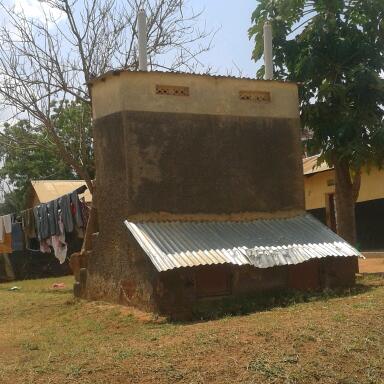 Replica.jpg
(Filesize: 33KB)
Replica.jpg
(Filesize: 33KB)
-
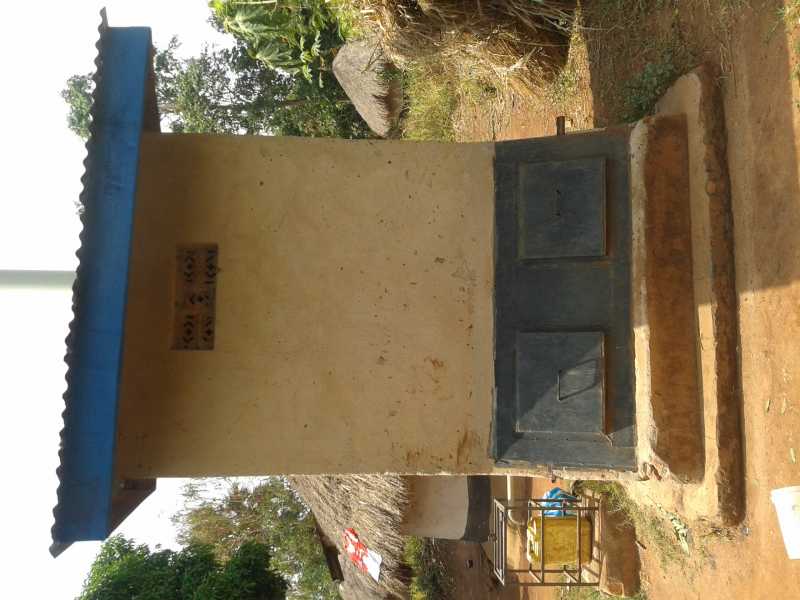 Demo_back.jpg
(Filesize: 48KB)
Demo_back.jpg
(Filesize: 48KB)
-
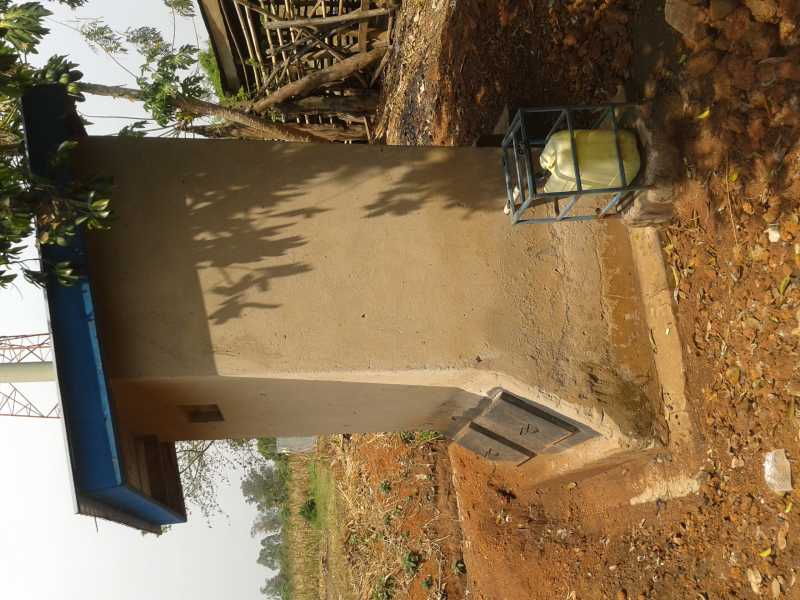 Demo_Side.jpg
(Filesize: 60KB)
Demo_Side.jpg
(Filesize: 60KB)
The following user(s) like this post: JKMakowka
Please Log in to join the conversation.
You need to login to replyRe: The oldest and biggest ecosan project in East Africa is still expanding, but slowly!!!
Dear Arnold,
sorry it again took me such a long time to respond! Here in Northern Uganda, the Ministry doesn't match the toilet design to the users - they seem to have only one model for family use, the well built (brick and mortar, and steel for the slab) design I was mentioning.
Thanks for sending the pictures - what are your experiences with such a design which seems to rely heavily on wood. In our area termites are a real problem and any wood that is in contact with the soil will very probably be attacked.
For the replacement of fittings, I think it is a point well taken. It is something we haven't really thought about. Our thrust so far has been on the promotion of the construction of the ecosan toilets, where, as explained, people do invest most of money themselves.
Kind regards, Hanns-Andre
sorry it again took me such a long time to respond! Here in Northern Uganda, the Ministry doesn't match the toilet design to the users - they seem to have only one model for family use, the well built (brick and mortar, and steel for the slab) design I was mentioning.
Thanks for sending the pictures - what are your experiences with such a design which seems to rely heavily on wood. In our area termites are a real problem and any wood that is in contact with the soil will very probably be attacked.
For the replacement of fittings, I think it is a point well taken. It is something we haven't really thought about. Our thrust so far has been on the promotion of the construction of the ecosan toilets, where, as explained, people do invest most of money themselves.
Kind regards, Hanns-Andre
Hanns-Andre Pitot
M.Eng. Environmental Pollution Control
presently in Seesen, Germany
M.Eng. Environmental Pollution Control
presently in Seesen, Germany
Please Log in to join the conversation.
You need to login to reply- bitwire2010
-
Less
- Posts: 14
- Likes received: 2
Re: The oldest and biggest ecosan project in East Africa is still expanding, but slowly!!!
Dear Hanns
Thanks for sharing on this important issue.
Yes, the eco-san seems to be expensive in the short run but it becomes cheaper in the long run since the structure is constructed once and for all.
And it depends on the surrounding housing status, if the benefiting family can afford to sleep in a tiled house, then they can afford an eco-san with iron roofed eco-san. Attached is the photo
Again it is good to try to construct the toilet using the readily available materials however good or bad they are in quality.
One thing you have to take care of is the commitment of the users to replace the broken parts of the pipes and fittings which you are giving to the people. A case example is in Rweshama landing site in south western Uganda, where households have failed to replace the broken parts waiting for the government and donors to do it for them.
I would suggest that you avail them to households at a subsidised cost and should be readily available this creates sense of ownership hence less misuse.
It’s good to come up with cheaper options for the poor, but also have in mind the maintenance costs and time involved in repairs and maintenance for sustainability.
Thanks for sharing
Arnold
Thanks for sharing on this important issue.
Yes, the eco-san seems to be expensive in the short run but it becomes cheaper in the long run since the structure is constructed once and for all.
And it depends on the surrounding housing status, if the benefiting family can afford to sleep in a tiled house, then they can afford an eco-san with iron roofed eco-san. Attached is the photo
Again it is good to try to construct the toilet using the readily available materials however good or bad they are in quality.
One thing you have to take care of is the commitment of the users to replace the broken parts of the pipes and fittings which you are giving to the people. A case example is in Rweshama landing site in south western Uganda, where households have failed to replace the broken parts waiting for the government and donors to do it for them.
I would suggest that you avail them to households at a subsidised cost and should be readily available this creates sense of ownership hence less misuse.
It’s good to come up with cheaper options for the poor, but also have in mind the maintenance costs and time involved in repairs and maintenance for sustainability.
Thanks for sharing
Arnold
Attachments:
-
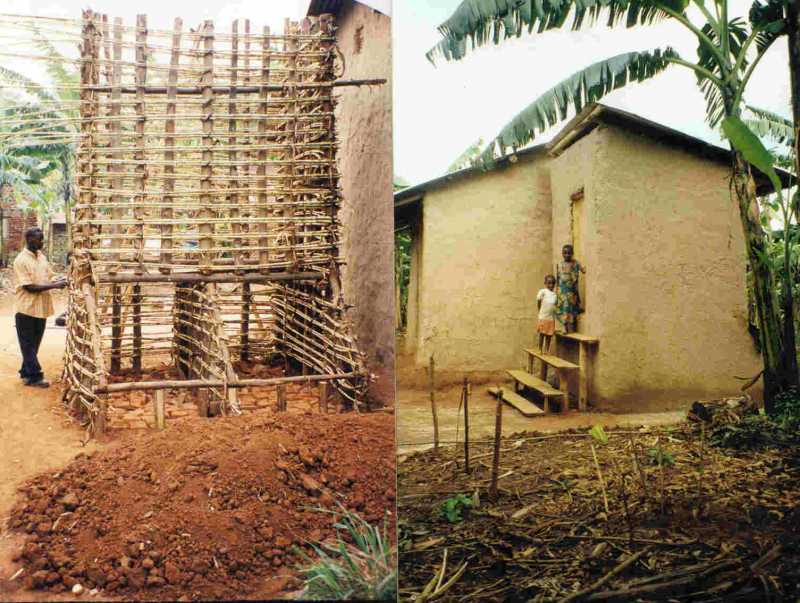 localEco-S...ooma.jpg
(Filesize: 78KB)
localEco-S...ooma.jpg
(Filesize: 78KB)
Please Log in to join the conversation.
You need to login to reply- bitwire2010
-
Less
- Posts: 14
- Likes received: 2
Re: The oldest and biggest ecosan project in East Africa is still expanding, but slowly!!!
Dear Arttu,
Thanks for for your comments on the case study. I am privileged to answer your questions and more explanation on selection criteria.
We have carried out trainings and sensitization workshops on eco-san, if the house is made of mud and wattle then the eco-san will be of the same building materials. The local government helped us in selection process. I have attached the selection criteria used.
Since the technology was new, the government of Uganda with the support from Austria provided the units at 100% subsidy. However there has been some replication were individuals have built the units at their own cost, we just give them technical support (drawings, boq and supervision).
Its a good technology but needs a lot of training and sensitization with followup on usage and application.
Otherwise you can always get in contact with me for any clarification.
Thanks
Arnold
Thanks for for your comments on the case study. I am privileged to answer your questions and more explanation on selection criteria.
We have carried out trainings and sensitization workshops on eco-san, if the house is made of mud and wattle then the eco-san will be of the same building materials. The local government helped us in selection process. I have attached the selection criteria used.
Since the technology was new, the government of Uganda with the support from Austria provided the units at 100% subsidy. However there has been some replication were individuals have built the units at their own cost, we just give them technical support (drawings, boq and supervision).
Its a good technology but needs a lot of training and sensitization with followup on usage and application.
Otherwise you can always get in contact with me for any clarification.
Thanks
This attachment is hidden for guests.
Please log in or register to see it.
Please log in or register to see it.
Arnold
This message has an attachment file.
Please log in or register to see it.
Please Log in to join the conversation.
You need to login to replyRe: The oldest and biggest ecosan project in East Africa is still expanding, but slowly!!!
Dear Arttu, dear Arnold, dear all,
Sorry for my late reply! - This issue of low-cost ecosan toilets has also been discussed here in Adjumani, Northern Uganda. But fist let me tell you something about the impact that our Austrian and Southern Ugandan colleagues seem to have had even in our region of Uganda. The Ministry of Water and Environment here in Uganda is now promoting the construction of ecosan toilets in all regions of the country inclusive of the Northern region. This is usually tied to water supply projects and is part of a sanitation component of such projects (which would, for example, usually also include public toilets of the flush type). They are typically organizing a training for a couple of local masons and constructing five demonstration ecosan toilets. The latter is also happening in Adjumani at the moment. Congratulations for this big impact that the Austria-funded project seems to have had!
Here in Adjumani, the question has, however, arisen whether it makes sense to construct the demonstration ecosan toilets of a top quality and seemingly with hardly any regard for the costs. This seems to have a deterring effect on the population. In most towns where these demonstration ecosan toilets have been constructed, there has been little sign that the local population is copying them, and the main reason seems to be the perceived costs of construction. Even though the ecosan toilets are seen to be desirable, they are also seen as costly and luxurious as a result of this approach.
Here in Adjumani, we have followed a different path (even though, as mentioned, the Ministry is also constructing five of the well constructed demonstration ecosan toilets). We have demonstrated one low cost toilet in a training for masons and contractors, and we are supporting UDDT-type ecosan toilets by making the parts for urine diversion (so called ecopans and the piping) available free of charge. The funding for this support has come from a so called sanitation levy on the tariff of piped water. This has helped promote the construction of ecosan toilets with now more than 40 that have been supported in Adjumani. Another 5 have been constructed by private means only.
As impressive as these nos. may seem, it is by far not corresponding to our expectations. What we are observing is that the ecosan toilets have been constructed by the wealthier sections of society, with the poor still sticking to the conventional pit latrine design. It seems that our message of the low-cost ecosan toilet hasn't reached the minds of the majority of the population. But it is my belief, that the majority of the people can only be interested in adopting an ecosan toilet via a low-cost model, which is perceived to be affordable. We now have a model on the drawing board that should cost just about 175 Euro for the complete toilet, incl. of the cabin. It is supposed to be tested in a new upcoming training for masons. I think it is that type of design that should be built as demonstration toilets rather the expensive concrete demo-toilets that are being built at the moment. If the beneficiaries are not satisfied with them, they can still make improvement (like cement plastering) at their own costs.
For some photos about the projects in Adjumani, see the following links:
www.flickr.com/photos/gtzecosan/sets/72157630727680876/
www.flickr.com/photos/gtzecosan/sets/72157631160051774/
Kind regards to everybody,
Hanns-Andre
Sorry for my late reply! - This issue of low-cost ecosan toilets has also been discussed here in Adjumani, Northern Uganda. But fist let me tell you something about the impact that our Austrian and Southern Ugandan colleagues seem to have had even in our region of Uganda. The Ministry of Water and Environment here in Uganda is now promoting the construction of ecosan toilets in all regions of the country inclusive of the Northern region. This is usually tied to water supply projects and is part of a sanitation component of such projects (which would, for example, usually also include public toilets of the flush type). They are typically organizing a training for a couple of local masons and constructing five demonstration ecosan toilets. The latter is also happening in Adjumani at the moment. Congratulations for this big impact that the Austria-funded project seems to have had!
Here in Adjumani, the question has, however, arisen whether it makes sense to construct the demonstration ecosan toilets of a top quality and seemingly with hardly any regard for the costs. This seems to have a deterring effect on the population. In most towns where these demonstration ecosan toilets have been constructed, there has been little sign that the local population is copying them, and the main reason seems to be the perceived costs of construction. Even though the ecosan toilets are seen to be desirable, they are also seen as costly and luxurious as a result of this approach.
Here in Adjumani, we have followed a different path (even though, as mentioned, the Ministry is also constructing five of the well constructed demonstration ecosan toilets). We have demonstrated one low cost toilet in a training for masons and contractors, and we are supporting UDDT-type ecosan toilets by making the parts for urine diversion (so called ecopans and the piping) available free of charge. The funding for this support has come from a so called sanitation levy on the tariff of piped water. This has helped promote the construction of ecosan toilets with now more than 40 that have been supported in Adjumani. Another 5 have been constructed by private means only.
As impressive as these nos. may seem, it is by far not corresponding to our expectations. What we are observing is that the ecosan toilets have been constructed by the wealthier sections of society, with the poor still sticking to the conventional pit latrine design. It seems that our message of the low-cost ecosan toilet hasn't reached the minds of the majority of the population. But it is my belief, that the majority of the people can only be interested in adopting an ecosan toilet via a low-cost model, which is perceived to be affordable. We now have a model on the drawing board that should cost just about 175 Euro for the complete toilet, incl. of the cabin. It is supposed to be tested in a new upcoming training for masons. I think it is that type of design that should be built as demonstration toilets rather the expensive concrete demo-toilets that are being built at the moment. If the beneficiaries are not satisfied with them, they can still make improvement (like cement plastering) at their own costs.
For some photos about the projects in Adjumani, see the following links:
www.flickr.com/photos/gtzecosan/sets/72157630727680876/
www.flickr.com/photos/gtzecosan/sets/72157631160051774/
Kind regards to everybody,
Hanns-Andre
Hanns-Andre Pitot
M.Eng. Environmental Pollution Control
presently in Seesen, Germany
M.Eng. Environmental Pollution Control
presently in Seesen, Germany
The following user(s) like this post: Elisabeth, bitwire2010
Please Log in to join the conversation.
You need to login to reply- avann
-
Less
- Posts: 3
- Likes received: 1
Re: The oldest and biggest ecosan project in East Africa is still expanding, but slowly!!!
THEREFORE IS IT BETTER TO PROMOTE CHEAP OR EXPENSIVE UDDTs? IF PEOPLE ARE TO COPY, WILL THEY COPY CHEAP OR EXPENSIVE DESIGNS?
I think it is a more complicated question. People will copy whatever designs suit their financial situation, practical needs and social status best. They also prioritize between these three. If their financial situation is good, they are (probably) willing to pay for quality design and materials. A good toilet facility may be a source of pride for them. On the other hand, if a household is short on income, they will first think of the price and their needs.
I'm interested in the practice of UDDT promotion. How have the different price categories been explained and marketed to different customer segments? Just mentioning that "this type of latrine is cheap to construct" may drive away those that don't want cheap but expensive/luxury.
Did you arrange workshops for whole communities or train individual households in the construction/use of the UDDTs? How did you engage with the local government officials? What criteria did you use to pick the households? Were there some pilot UDDTs in villages that were built by government money or did households buy their own UDDTs?
I am asking all these questions as I'm interested in your experiences in promoting UDDTs
Best regards
Arttu Vanninen
2015-2017: student in HVAC Technology, M.Sc.(Tech.), Aalto University
2013: Assisting Project Coordinator in the North South Local Government Cooperation Project:
Lahti, Finland - Rustenburg & Madibeng, South Africa - Ho, Ghana. Website: lahti-bojanala.net
2012: Bachelor of Engineering degree on Environmental engineering, Lahti University of Applied Sciences
2013: Assisting Project Coordinator in the North South Local Government Cooperation Project:
Lahti, Finland - Rustenburg & Madibeng, South Africa - Ho, Ghana. Website: lahti-bojanala.net
2012: Bachelor of Engineering degree on Environmental engineering, Lahti University of Applied Sciences
The following user(s) like this post: bitwire2010
Please Log in to join the conversation.
You need to login to reply- bitwire2010
-
Less
- Posts: 14
- Likes received: 2
Re: The oldest and biggest ecosan project in East Africa is still expanding, but slowly!!!
This project started in 1996, with the construction of Eco-san in western Uganda. The project has been promoting eco-san units at household level. However there has been a challenge on the slow replication of the technology in the region. This was partly due to the cost and the type. As the project was busy promoting the eco-san made from the local materials (mud and wattle) which was cheap and affordable for the poor, people were not ready to copy what the poor do, neither the poor could replicate.
This led to slow development of the successful design to go on scale in western Uganda.
THEREFORE IS IT BETTER TO PROMOTE CHEAP OR EXPENSIVE UDDTs? IF PEOPLE ARE TO COPY, WILL THEY COPY CHEAP OR EXPENSIVE DESIGNS?
Thanks
Arnold Asiimwe
+++++++++++
Additional notes by moderator (Elisabeth von Muench):
Link to the case study that describes this project:
www.susana.org/lang-en/case-studies?view...eitem&type=2&id=1558
Kwikiriza, L., Asiimwe, A. Nuwamanya, H., Schattauer, H. (2012). Large-scale peri-urban and rural sanitation with UDDTs, South Western region, Uganda - Case study of sustainable sanitation projects. Sustainable Sanitation Alliance (SuSanA).
Link to photos part 1:
www.flickr.com/photos/gtzecosan/sets/72157631001526388/
Link to photos part 2:
www.flickr.com/photos/gtzecosan/sets/72157631399172126/
It is a very good case study. I know because I did the QA checking for it.
One photo as an eye catcher:
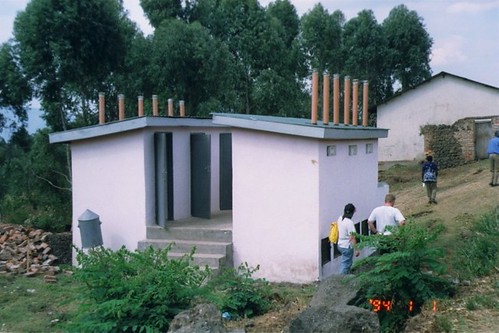
0029 UDDT at a school in Kisoro, 2000, left side for girls, right side for boys by Sustainable sanitation , on Flickr
Summary of the project case study:
Large-scale peri-urban and rural sanitation with UDDTs, South Western region, Uganda
Case study of sustainable sanitation projects
The South Western Towns Water and Sanitation (SWTWS) project was created in 1995 to provide water supply and improve sanitation in 19 small towns and rural centres in South West Uganda. Implementation of the program started in 1996 with a grant from the Austrian Government. The main focus was on providing water and sanitation systems with low operation and maintenance costs to ensure sustainability given the low income levels of the beneficiaries. Basic sanitation (at least a pit latrine with a sanitation platform, sanplat) for each house hold was the mandatory requirement before water was supplied to a town.
Pit latrines which were commonly used were not suitable for all areas. In some areas they polluted the underground source of drinking water while in water logged areas the pits collapsed. It was then that ecological sanitation (ecosan) technology was identified as a possible solution for such areas.
However, an attempt to introduce ecosan was met with stiff resistance, by the communities as it was unheard of to reuse human excreta. The first units that were constructed were made of partially underground composting toilets, where urine and faeces mixed, but these were later abandoned in favour of the dehydrating above the ground types (UDDTs). Maintaining compost toilets was difficult for the community. Since they looked more like the traditional pit latrines people either failed or neglected to add dry material (ash, soil or compost) to the vaults after defecation. At other times ground water would found its way into the chambers and turned them septic.
From the experiences in the south western region, workshops and discussions were held and it was agreed that Ecological sanitation concepts would be beneficial for the entire country especially the problematic areas. The technology being promoted by the project is a double vault urine diverting dehydrating toilet (UDDT). UDDTs are preferred over the traditional pit latrines that have been common in the area because: they do not contaminate ground water sources, faeces can be recycled for use in gardens and they do not smell or attract flies. Faecal phobic attitudes in communities are fading as people are now readily eating food, which they know has been grown using treated human wastes.
Number of toilets built: 927 (6 persons per household)
Number of people with access to toilets: 5562
Total investment for sanitation part: EUR 420,000
Number of people covered with water supply: 530,093 (this is the total population in the project towns (regional growth centres and small towns))
Start of construction: 1996
End of construction: Toilet construction is an ongoing process (15 days to construct one toilet)
Start of operation: Directly after construction of each toilet
Project end: 2013 (funds for four more years beyond 2013 might be forthcoming)
This project has so far gone through three phases: South Western Towns Water and Sanitation Project (SWTWSP):
SWTWSP I 1996 - 2002
SWTWSP II 2002 - 2006
SWTWSP III 2006 - 2013
This led to slow development of the successful design to go on scale in western Uganda.
THEREFORE IS IT BETTER TO PROMOTE CHEAP OR EXPENSIVE UDDTs? IF PEOPLE ARE TO COPY, WILL THEY COPY CHEAP OR EXPENSIVE DESIGNS?
Thanks
Arnold Asiimwe
+++++++++++
Additional notes by moderator (Elisabeth von Muench):
Link to the case study that describes this project:
www.susana.org/lang-en/case-studies?view...eitem&type=2&id=1558
Kwikiriza, L., Asiimwe, A. Nuwamanya, H., Schattauer, H. (2012). Large-scale peri-urban and rural sanitation with UDDTs, South Western region, Uganda - Case study of sustainable sanitation projects. Sustainable Sanitation Alliance (SuSanA).
Link to photos part 1:
www.flickr.com/photos/gtzecosan/sets/72157631001526388/
Link to photos part 2:
www.flickr.com/photos/gtzecosan/sets/72157631399172126/
It is a very good case study. I know because I did the QA checking for it.
One photo as an eye catcher:

0029 UDDT at a school in Kisoro, 2000, left side for girls, right side for boys by Sustainable sanitation , on Flickr
Summary of the project case study:
Large-scale peri-urban and rural sanitation with UDDTs, South Western region, Uganda
Case study of sustainable sanitation projects
The South Western Towns Water and Sanitation (SWTWS) project was created in 1995 to provide water supply and improve sanitation in 19 small towns and rural centres in South West Uganda. Implementation of the program started in 1996 with a grant from the Austrian Government. The main focus was on providing water and sanitation systems with low operation and maintenance costs to ensure sustainability given the low income levels of the beneficiaries. Basic sanitation (at least a pit latrine with a sanitation platform, sanplat) for each house hold was the mandatory requirement before water was supplied to a town.
Pit latrines which were commonly used were not suitable for all areas. In some areas they polluted the underground source of drinking water while in water logged areas the pits collapsed. It was then that ecological sanitation (ecosan) technology was identified as a possible solution for such areas.
However, an attempt to introduce ecosan was met with stiff resistance, by the communities as it was unheard of to reuse human excreta. The first units that were constructed were made of partially underground composting toilets, where urine and faeces mixed, but these were later abandoned in favour of the dehydrating above the ground types (UDDTs). Maintaining compost toilets was difficult for the community. Since they looked more like the traditional pit latrines people either failed or neglected to add dry material (ash, soil or compost) to the vaults after defecation. At other times ground water would found its way into the chambers and turned them septic.
From the experiences in the south western region, workshops and discussions were held and it was agreed that Ecological sanitation concepts would be beneficial for the entire country especially the problematic areas. The technology being promoted by the project is a double vault urine diverting dehydrating toilet (UDDT). UDDTs are preferred over the traditional pit latrines that have been common in the area because: they do not contaminate ground water sources, faeces can be recycled for use in gardens and they do not smell or attract flies. Faecal phobic attitudes in communities are fading as people are now readily eating food, which they know has been grown using treated human wastes.
Number of toilets built: 927 (6 persons per household)
Number of people with access to toilets: 5562
Total investment for sanitation part: EUR 420,000
Number of people covered with water supply: 530,093 (this is the total population in the project towns (regional growth centres and small towns))
Start of construction: 1996
End of construction: Toilet construction is an ongoing process (15 days to construct one toilet)
Start of operation: Directly after construction of each toilet
Project end: 2013 (funds for four more years beyond 2013 might be forthcoming)
This project has so far gone through three phases: South Western Towns Water and Sanitation Project (SWTWSP):
SWTWSP I 1996 - 2002
SWTWSP II 2002 - 2006
SWTWSP III 2006 - 2013
Please Log in to join the conversation.
You need to login to reply- cniwagaba
-
Topic AuthorLess
- Posts: 3
- Karma: 2
- Likes received: 3
Examples of ecological sanitation at scale
Hi,
Just a little bit about Uganda - The coverage of ecosan in Uganda is not well known, by the way, so the 7% is just an estimate. Estimates from practitioners put the ecosan contribution to be some 10,000 - 15,000 UDDT toilet units in Uganda but there is no document to support these estimates.
It is true that the 10 year ecosan strategy for Uganda 2008-2018 has as an overall strategy goal: 'In 2018, quality of life in Uganda is improved as water resources and human health are protected by safe excreta management through sustainable ecological sanitation systems which are implemented at least at 15% of the total sanitation coverage in the country'. However, even if the strategy goal is nicely stated, there is no dedicated effort to commit resources to increase the coverage of ecosan in Uganda.
Therefore, even the 15% might not be easily met in 2018. The Uganda Ecosan strategy is about 4 years old now, but I do not think that it is being implemented the way it was written. On the good part of it, we estimated the ecosan (in terms of UDDTs) coverage in Kabale town in 2009 and published the work in 2011 in International Journal of Environmental Health Research. We found that in 2009, the ecosan (in terms of UDDTs) coverage in Kabale town with a population of about 45,000 people was about 20%, which was higher than the national targeted value of 15% by 2018.
The details can be accessed in the full paper: Tumwebaze, I.K., Orach, G.C., Kalyango, J.N., Lüthi, C., Nakiwogga, A., Karamagi, C., Niwagaba, B.C. 2011. Ecological sanitation coverage and factors affecting its uptake in Kabale Municipality, Western Uganda. International Journal of Environmental Health Research 21(4), 294-305; which you can search from the web.
Kabale town is in Southwestern Uganda and it is one of the towns where the implementation of Ecosan started in Uganda, with the support of the Government of Austria way back in around 1997/98. Whoever wants to see large scale application of ecosan in Uganda, we send them to Kabale and Kisoro. Actually, about two weeks ago, I received a group of 12 masters students from the University of Dar es Salaam, whom I had taught a module of Ecosan about one month ago, and they came to Uganda to be able to visit Kabale to see large scale application of UDDTs. They were very impressed.
Charles
Dr. Charles B. Niwagaba, PhD
Lecturer & Head of Department (Ag),
Civil & Environmental Engineering
College of Engineering, Design, Art and Technology
Makerere University
P. O. Box 7062
Kampala, UGANDA
www.mak.ac.ug
Just a little bit about Uganda - The coverage of ecosan in Uganda is not well known, by the way, so the 7% is just an estimate. Estimates from practitioners put the ecosan contribution to be some 10,000 - 15,000 UDDT toilet units in Uganda but there is no document to support these estimates.
It is true that the 10 year ecosan strategy for Uganda 2008-2018 has as an overall strategy goal: 'In 2018, quality of life in Uganda is improved as water resources and human health are protected by safe excreta management through sustainable ecological sanitation systems which are implemented at least at 15% of the total sanitation coverage in the country'. However, even if the strategy goal is nicely stated, there is no dedicated effort to commit resources to increase the coverage of ecosan in Uganda.
Therefore, even the 15% might not be easily met in 2018. The Uganda Ecosan strategy is about 4 years old now, but I do not think that it is being implemented the way it was written. On the good part of it, we estimated the ecosan (in terms of UDDTs) coverage in Kabale town in 2009 and published the work in 2011 in International Journal of Environmental Health Research. We found that in 2009, the ecosan (in terms of UDDTs) coverage in Kabale town with a population of about 45,000 people was about 20%, which was higher than the national targeted value of 15% by 2018.
The details can be accessed in the full paper: Tumwebaze, I.K., Orach, G.C., Kalyango, J.N., Lüthi, C., Nakiwogga, A., Karamagi, C., Niwagaba, B.C. 2011. Ecological sanitation coverage and factors affecting its uptake in Kabale Municipality, Western Uganda. International Journal of Environmental Health Research 21(4), 294-305; which you can search from the web.
Kabale town is in Southwestern Uganda and it is one of the towns where the implementation of Ecosan started in Uganda, with the support of the Government of Austria way back in around 1997/98. Whoever wants to see large scale application of ecosan in Uganda, we send them to Kabale and Kisoro. Actually, about two weeks ago, I received a group of 12 masters students from the University of Dar es Salaam, whom I had taught a module of Ecosan about one month ago, and they came to Uganda to be able to visit Kabale to see large scale application of UDDTs. They were very impressed.
Charles
Dr. Charles B. Niwagaba, PhD
Lecturer & Head of Department (Ag),
Civil & Environmental Engineering
College of Engineering, Design, Art and Technology
Makerere University
P. O. Box 7062
Kampala, UGANDA
www.mak.ac.ug
The following user(s) like this post: Elisabeth, madeleine
Please Log in to join the conversation.
You need to login to reply
Share this thread:
- Sanitation systems
- Toilets with urine diversion
- UDDTs (urine-diverting dry toilets)
- Replication challenges with urine-diverting dry toilets (UDDTs) in Uganda
Recently active users. Who else has been active?
Time to create page: 0.150 seconds








